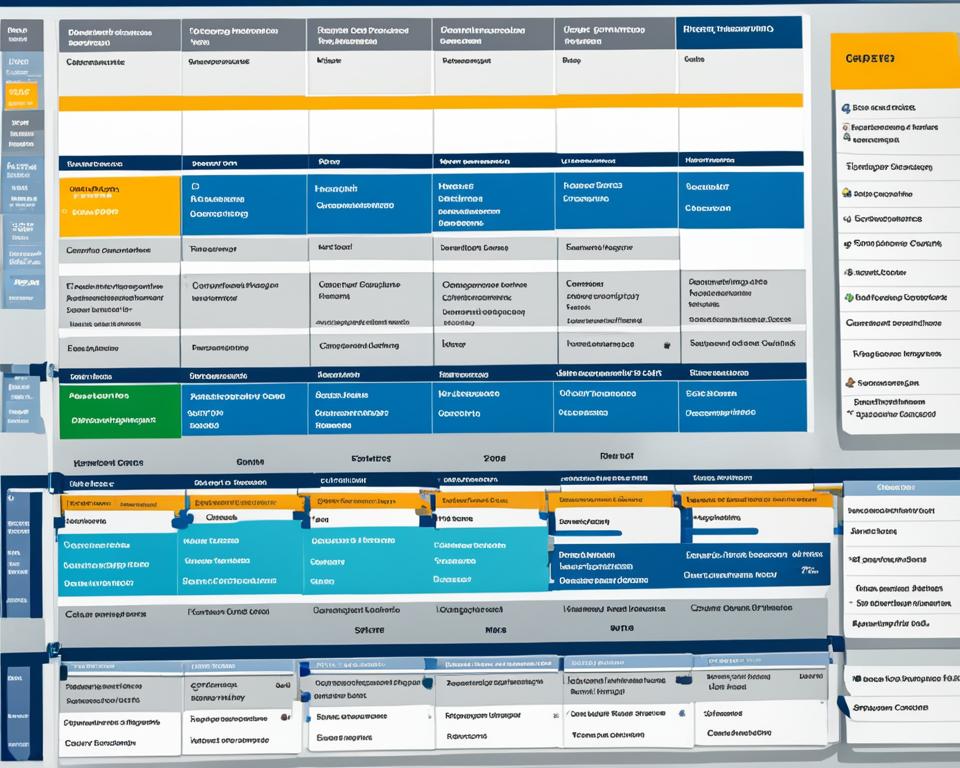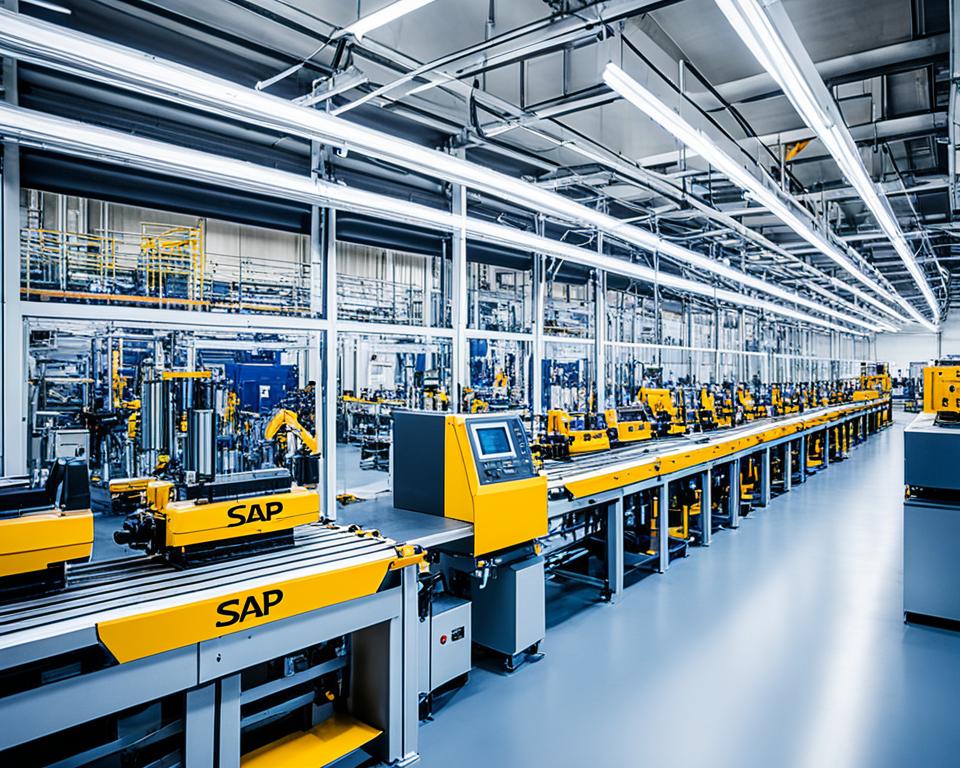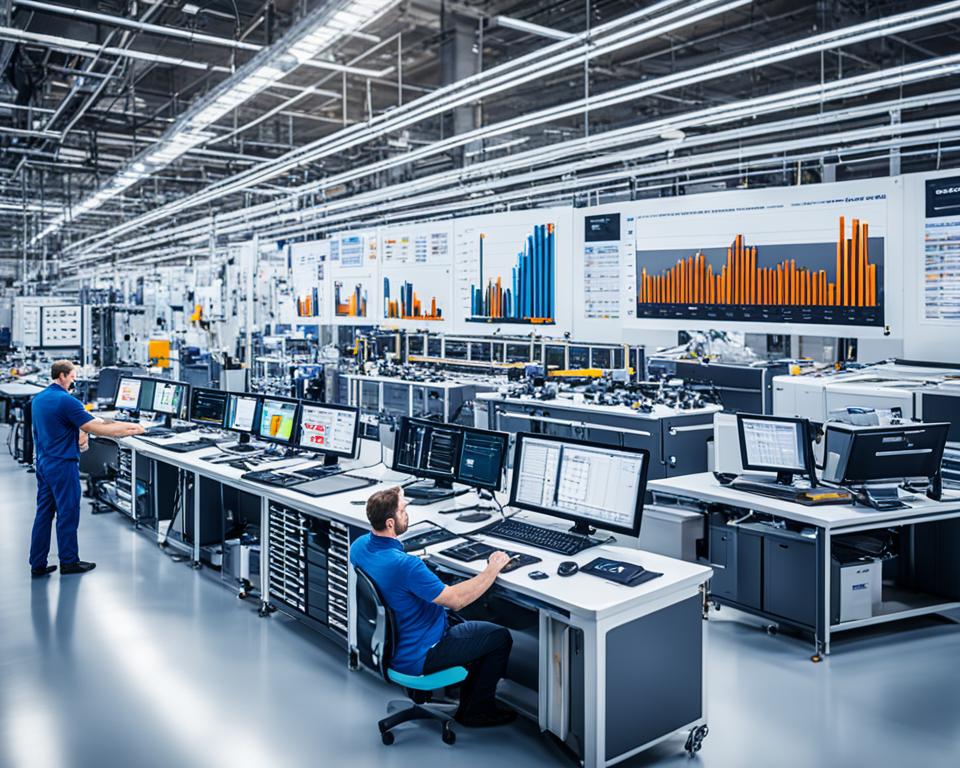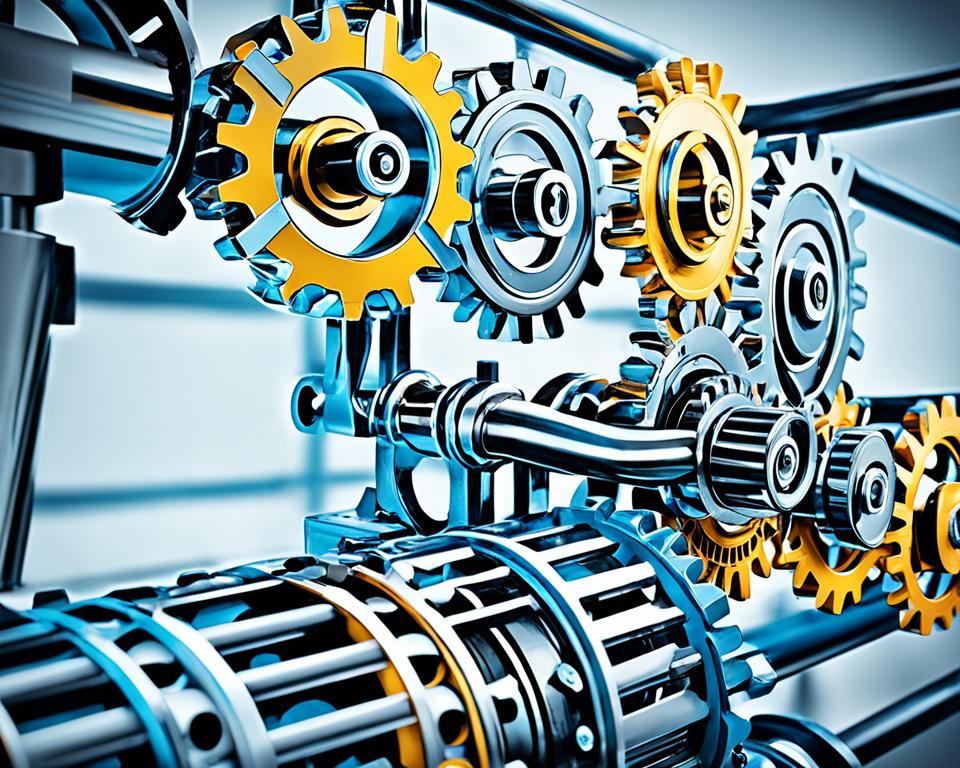Have you ever thought about how modern manufacturing can stay ahead in a world that values speed and efficiency? The key often is using tools like SAP MRS (Multi-Resource Scheduling). This powerful tool helps make operations better by improving how resources are used and making production smoother. By optimizing resources, I’ve seen companies meet their goals in production planning. In this article, I’ll dive into what SAP MRS does and why it’s vital for today’s manufacturing world.
Key Takeaways
- SAP MRS makes using resources more efficient.
- Good production planning is key to success.
- Multi-Resource Scheduling boosts how well resources are used.
- Working well with other systems is crucial for the best results.
- Being able to schedule in real-time gives a competitive edge.
- Knowing how SAP MRS works can make operations run better.
Introduction to Multi-Resource Scheduling
Multi-Resource Scheduling (MRS) is a key method for managing many resources for different tasks. It’s vital in production planning. It helps companies use their people, machines, and materials well. As businesses grow and get more complex, managing these resources well is crucial.
Using MRS boosts resource optimization in many fields. Companies can handle workflows and use assets better, making operations run smoother. By learning about MRS, I see how important it is in today’s manufacturing and service sectors.
MRS makes processes more efficient, making sure all resources match project needs. This setup helps tasks get done well and cuts down on idle times and bottlenecks. As someone focused on improving systems, looking into its advanced features, like SAP MRS, is very useful.
Understanding SAP MRS and Its Functionality
SAP MRS is a key player in scheduling software. It boosts operational efficiency by optimizing resource use. This tool helps solve complex resource planning issues with real-time scheduling and adjustments for changing production needs.
At its core, SAP MRS can change production schedules on the fly. If resources change, it quickly adjusts with advanced scheduling algorithms. This keeps operations running smoothly, even when things get unpredictable.
Being able to adjust scheduling settings is key to using resources well. Users can tailor settings to fit their needs, like considering machine limits or prioritizing orders. This flexibility makes sure resources match up with production demands well.
SAP MRS also makes it easy for teams to manage their resources. It groups users by their roles, giving them the right tools. This approach cuts down on confusion and improves communication between departments.
In short, knowing how SAP MRS works helps companies use it to optimize resources and improve their scheduling. This leads to better efficiency and productivity.

The Importance of Resource Optimization
Resource optimization is key in the manufacturing world. It boosts productivity, cuts costs, and improves quality. By managing resources well, I can reduce waste and downtime. This leads to better performance and efficiency.
Companies look for new ways to manage resources better. This leads to better results in their operations.
Benefits of Resource Optimization in Manufacturing
Optimizing resources brings big benefits to manufacturers. These include:
- Improved capacity management: Matches production with market needs.
- Faster response times: Allows quick changes in production.
- Increased agility: Helps adapt to new challenges and chances.
How SAP MRS Enhances Resource Utilization
SAP MRS is a top choice for managing manufacturing systems. It helps me use resources like labor and machinery better. With SAP MRS, my company can use resources more efficiently and meet production goals faster. This leads to more output and better manufacturing efficiency.
| Benefits | Impact on Manufacturing |
|---|---|
| Improved capacity management | Matches production capabilities with market demand |
| Faster response times | Enables quick adjustments for production changes |
| Increased agility | Facilitates adaptation to new challenges |
Key Features of SAP MRS
SAP MRS has many important features that make operations run better and manage resources well. It’s easy to use and works well with other systems, making it a top choice for scheduling tools.
User-Friendly Interface
The user-friendly interface of SAP MRS is a big plus. It’s designed so that people of all skills can use it easily. This means less training time and more getting things done quickly.
Users can easily change schedules and manage resources. This helps make work more productive and cuts down on delays.
Integration with Existing Systems
Another big feature is how well it works with other systems. SAP MRS connects smoothly with systems like manufacturing execution and enterprise resource planning. This means data moves easily between platforms, giving a clear view of operations.
This integration helps avoid problems that could slow down teamwork. It makes working together easier within the company.

| Feature | Description |
|---|---|
| User-Friendly Interface | Intuitive layout simplifies navigation for all users. |
| Existing Systems Integration | Seamless connection with other manufacturing and planning tools. |
| Efficiency Improvement | Optimizes resource utilization and scheduling processes. |
| Data Flow Management | Ensures consistent communication between various platforms. |
Knowing what SAP MRS can do helps companies use it to its fullest. For more on how SAP can improve operations, check out ABAP Reports and their role in custom reporting.
Production Planning and Scheduling with SAP MRS
Planning and scheduling production is key to making manufacturing successful. SAP MRS helps businesses match production goals with what they have. This means they can manage resources better and avoid production delays.
Aligning Production Targets with Resources
SAP MRS makes it easy to connect production goals with what the company can do. This way, I can make sure resources are used well to meet changing production needs. It helps keep the workflow smooth and production levels steady without using too many resources.
Real-Time Scheduling Capabilities
SAP MRS is great for making quick changes in production plans. It lets businesses adjust plans fast when production needs or resource availability change. Making fast decisions can cut down on inventory costs and improve service levels. This makes production more flexible and efficient.
Capacity Management in Manufacturing
Effective capacity management is key to making the most of what you can produce and meeting customer needs. I’ve seen that using SAP MRS helps companies improve their manufacturing optimization. This software has tools to check how well resources are used and spot where production might slow down.
SAP MRS uses data to help businesses understand their limits. With this knowledge, they can make workflows better, leading to more efficient production. Having a good plan for managing capacity helps improve how well things run and keeps customers happy.

The following table shows the benefits of using SAP MRS for capacity management:
| Benefits | Description |
|---|---|
| Improved Resource Allocation | Maximizes the use of available resources, ensuring efficiency in every production cycle. |
| Reduced Downtime | Minimizes production delays by anticipating and resolving potential bottlenecks early. |
| Enhanced Flexibility | Allows businesses to adapt quickly to changes in demand and production requirements. |
| Data-Driven Decisions | Utilizes real-time data to inform strategic planning and operational adjustments. |
Using SAP MRS helps companies improve how they manage capacity. This leads to better use of resources and is crucial for success in a competitive market. For more details on how SAP MRS can help with manufacturing optimization, check out this resource.
Utilizing Scheduling Software for Improved Efficiency
The choice of scheduling software is key to better performance. It’s important to know what your organization needs. Look for software that can grow with you, customize to your processes, and work well with other tech.
By focusing on these factors, you can make your team work more efficiently. This leads to better use of resources.
Choosing the Right Scheduling Software
When picking scheduling software, consider these points:
- Scalability: Make sure it can expand as your business does.
- Customization: Choose features that fit your specific needs.
- Integration capabilities: It should work well with your current tech.
- User-friendliness: A simple interface helps your team use it easily.
Comparing SAP MRS with Other Solutions
Looking at SAP MRS and other options shows its benefits:
| Feature | SAP MRS | Competitor A | Competitor B |
|---|---|---|---|
| Resource Optimization | Advanced algorithms for enhanced efficiency | Basic functionality | Moderate capabilities |
| Integration with ERP | Seamless integration with SAP systems | Limited integration options | Moderate integration capabilities |
| Customization | Highly customizable dashboards | Predefined templates | Limited customization options |
| User Support | Extensive support resources | Limited support availability | Decent customer service |
SAP MRS and Lean Manufacturing Principles
Lean manufacturing aims to cut waste and boost productivity. SAP MRS fits perfectly with these goals, making operations more efficient in many manufacturing areas. It uses real-time data to improve key processes, cutting down on waste.

SAP MRS helps with continuous improvement in lean manufacturing. It makes it easier to manage resources and schedules. This means manufacturers can quickly adjust to demand changes, making production more flexible. This leads to better use of resources in real situations, bringing real benefits.
Using SAP MRS helps companies put lean ideas into action. This includes:
- Streamlined operations that cut down on lead times.
- Clearer insight into how resources are used and what they need.
- More flexibility to respond to market shifts.
With SAP MRS, companies can keep improving. They can check their performance and make smart choices based on data. For more on improving SAP systems, check out ABAP Debugging and Performance Tuning.
The mix of SAP MRS and lean manufacturing creates a strong plan for better operations. This approach helps manufacturers succeed in today’s competitive world.
Impact of SAP MRS on Supply Chain Management
SAP MRS is key to making supply chains work better. It helps companies work more efficiently from start to finish. This makes it easier to meet the fast pace of today’s market.
Streamlining Supply Chain Processes
SAP MRS makes supply chains run smoother by automating and optimizing workflows. It helps manage resources well, making sure every step in the chain works well. This means shorter wait times, lower costs, and more work done.
With better visibility, companies can make quicker decisions. They can also handle changes in demand better.
Improving Collaboration Across Departments
Working together well is key in supply chains, and SAP MRS helps with that. It gives real-time data and helps teams work together. This breaks down barriers between departments, aiming for everyone’s goals.
This teamwork leads to a supply chain that’s quick to adapt to new trends and customer needs. For more on how SAP Ariba solutions help, check out these success stories.
Integrating SAP MRS with Enterprise Resource Planning
Linking SAP MRS with current ERP systems is a smart move for companies wanting to improve how they work. This connection brings new features that make workflows smoother and better use of resources. It also makes sure info moves easily between departments, helping with smarter decisions.
By doing this, companies get better at predicting what they need. Departments work together better, making sure their work matches the company’s big goals. Being able to quickly adjust to new situations makes using SAP MRS with ERP even more valuable.
Companies often start by adding these systems bit by bit. This way, they can test and tweak the setup to make sure it works well. This leads to more work getting done and operations running smoother, making things more efficient overall.
Diving into Digital Transformation with SAP MRS
Digital transformation is changing how businesses work. SAP MRS leads this change. It makes managing resources better by automating old, time-consuming tasks.
This automation cuts down on mistakes and boosts efficiency. Teams can then work on big projects instead of daily chores.
Using data analytics in SAP MRS gives deep insights into how resources are used. This helps in making better decisions and encourages ongoing improvement. With SAP MRS, businesses can quickly adjust to changes in demand or other issues.
These advanced features help in bringing new ideas to life. They let businesses grow while keeping a handle on their resources. In today’s market, being able to change and grow through digital transformation is key.
Real-World Case Studies of SAP MRS Implementation
Looking at real-world examples shows how SAP MRS has made a big difference. Many companies have seen great results from using it. This journey has changed how they work for the better.
Success Stories from Various Industries
Many industries have seen big wins with SAP MRS. For example, a manufacturing company boosted its production by 30% with SAP MRS. In logistics, a firm made its scheduling better, cutting down on conflicts and speeding up deliveries.
Lessons Learned from Implementation Challenges
Implementing SAP MRS isn’t always easy, as many case studies show. Companies often struggle with integrating it with their current systems. But, learning from these issues, they’ve found that careful planning and training are key. Doing this helps make the switch smoother and quicker.

Future of Operations Optimization with SAP MRS
The world of operations optimization is changing fast, thanks to new tech like AI, IoT, and machine learning. SAP MRS is set to play a big role in this change, offering new ways to manage resources better. By combining these technologies with SAP MRS, we’ll see more accuracy and speed in planning and using resources. This will help businesses quickly adapt to new market needs and challenges.
Big data analytics and real-time monitoring are becoming key trends in operations optimization. For example, predictive analytics can spot potential production issues early, helping us adjust resources before problems start. This smart planning, thanks to SAP MRS’s future, will cut down on downtime and boost productivity.
Companies that adopt these new technologies with SAP MRS will likely see big gains in efficiency. I believe the mix of old and new tech will change the manufacturing world. It will lead to a smoother, more efficient future for everyone.
Conclusion
SAP MRS is a key tool for improving operations in manufacturing and related fields. It helps companies like mine make production smoother. By managing resources well, it boosts overall efficiency.
This tool also makes it easier to plan production and complete projects on time. It keeps quality high. Using SAP MRS helps me stay ahead in a changing market.
For businesses aiming for the top, SAP MRS is a great choice. It leads to better productivity and efficiency. Using this platform is key to being ready for the future.



Leave a Reply